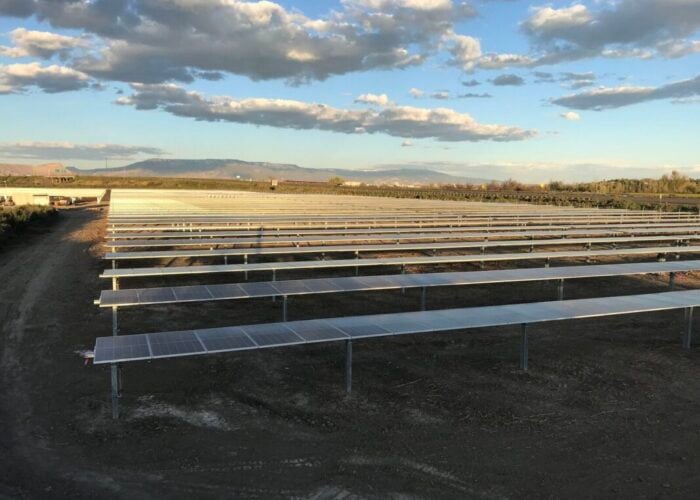
Australian thinktank Climate Energy Finance (CEF) has forecast global solar module manufacturing capacity to reach 1.8TW by the end of the year.
This would be triple the installations registered globally in 2024, with China responsible for most of the supply chain.
Try Premium for just $1
- Full premium access for the first month at only $1
- Converts to an annual rate after 30 days unless cancelled
- Cancel anytime during the trial period
Premium Benefits
- Expert industry analysis and interviews
- Digital access to PV Tech Power journal
- Exclusive event discounts
Or get the full Premium subscription right away
Or continue reading this article for free
Despite ongoing manufacturing overcapacity, CEF described a “relentless” investment in the solar PV supply chain, driving a 29% year-on-year manufacturing capacity increase in China in 2024. This is a trend that CEF expects to continue in 2025, which may stabilise some of the record low module prices seen in the industry.
“With global manufacturing capacity at 2-3 times current global install rates, CEF does advocate for the global industry to immediately suspend all non-essential capacity expansions for several years,” said the CEF.
This overcapacity across the PV supply chain, along with the intensification of price competition, will drive the industry to consolidation and the collapse of “weaker” competition, said CEF, a sentiment shared by LONGi president Li Zhenguo earlier this month (Premium access).
Outside of China, policy uncertainty and high costs are delaying Western manufacturing projects, according to CEF. It added that the implementation of tariffs has provided some protection to domestic manufacturing in the US and India, with the former recently reaching 50GW of annual nameplate for PV modules. However, the thinktank suggests policymakers focus on exploring strategic partnerships with Chinese companies to support domestic production.
Australia would be an example of this collaboration with Chinese companies to expand domestic solar manufacturing capacity. Among the examples given is the joint venture between cell startup SunDrive Solar and Chinese solar manufacturer TrinaSolar, which aims to scale solar manufacturing opportunities in Australia.
“Expanding on these initiatives with targeted industrial incentives, realistic local content policies and further trade agreements is essential to securing Australia’s future as a competitive, low-cost, clean energy exporter and innovator,” wrote CEF.
Trump’s ‘protectionism’ to divert US investment in clean energy manufacturing
The US has doubled down on its protectionist trade policy in recent months, imposing and raising tariffs on Chinese projects throughout the Trump administration.
The US administration’s stance in imposing tariffs for solar products early on could have a negative effect by driving cost inflation for energy consumers and “cause capital flight”, with companies in the energy storage industry cancelling manufacturing plans, such as startup KORE Power.
CEF estimates that at the end of 2025, the US will have an annual nameplate production of 55-60GW for solar modules, assuming nearly 10GW of manufacturing proposal cancellations.
Moreover, India’s accelerated domestic PV module manufacturing is hampered by its continued reliance on Chinese solar wafers and cells, exposing the country to US trade sanctions, according to the report. This risk of being exposed to Trump’s protectionism and external dependencies could be reduced with the country doubling down on driving domestic solar installation rates.
Solar PV leading technology for lowest LCOE by 2030
Solar PV is forecast to become the technology with the lowest levelised cost of electricity (LCOE) globally by 2030, with only a few countries in Europe where onshore wind will be the leading technology.
The improved economics of longer-duration batteries have allowed the growth of co-located solar-plus-storage deployments with the two technologies being cost competitive compared to new coal-fired power plants and fossil gas power plants in many markets since 2020. For instance, this year solar-plus-storage projects have become competitive with coal generation in India and gas generation in Germany.
Furthermore, the global average capital expenditure (capex) for solar PV projects has drastically reduced from US$3,000/kW in 2014-2016 to nearly US$1,000/kW in 2024-26, according to CEF. This was driven by solar cell and module efficiency improvements, which have cut costs by 60%. PV module prices have remained a “critical driver” for the decline of solar PV capex, explained CEF, along with the collapse of polysilicon prices in the last couple of years.
The US remains an outlier in this situation, with average capex exceeding US$1,200/kW due to tariffs on imported solar modules. On the other hand, some Asian markets have achieved lower costs, in the range of US$500-700/kW, including India and Australia.






